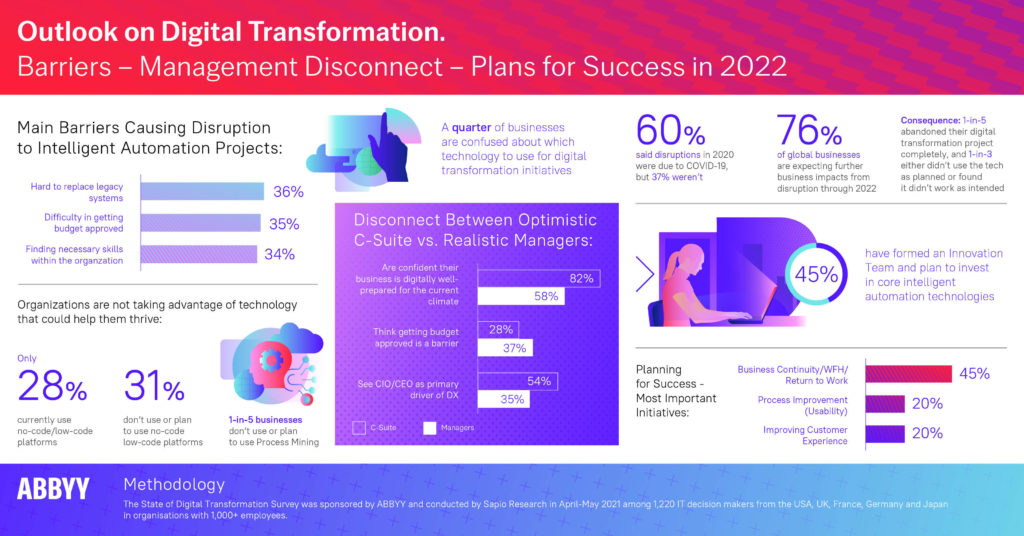Successful Digital Transformation begins with Understanding Cloud Services
In the equipment finance industry, technology has risen to the top of the food chain as digital transformation can help many businesses become highly efficient with the same team and no increase in headcount. What has been found is the fact that only 41 percent of businesses say the Board is driving digital transformation and one of the top barriers to transformation is lack of in-house skills and expertise. 1 However, when it comes to digital transformation, what does it really look like? We have been talking about it for over a decade. And given the complexity of IT demands from an operational efficiency perspective, many decision makers get bogged down with daily ops and lose sight of the real benefits and how it can make a difference for growth in the future. The problem is only 40% of executives reported that the top benefit of digital transformation was operational efficiency, while 36% said it was faster time to market (PTC, 2019).
Despite the myriad benefits of adopting digital technologies, the fact of the matter is that large-scale digital transformation programs can be difficult to get off the ground. In fact, a recent PTC survey 3a of 1,500 digital transformation projects shows that nearly half failed to achieve positive ROI, with the common pain points like data inaccessibility and siloed systems forestalling efforts.3a
And understanding of the Cloud that support any digital transformation can be a concern for many within the company. IT Teams everywhere are at maximum already. And while the Cloud has been around and nothing new, having time to evaluate the best solution and how it does transform the business is something many IT departments have to put at the bottom of the list.
Also, when it comes to understanding the 2022 and beyond barriers to bringing digital transformation into any enterprise, the biggest concerns is replacing a legacy system and then the cost associated with that replacement, not to mention the disruption it can cause. However, if companies do not plan and begin executing an update to their legacy system, they will be left behind and competitors will begin to creep in on their business, and it will be a critical error that many did not see coming.
As you can see in the infographic below, the consequences of NOT updating a system is ‘…consequence: 1-in-5 abandoned their digital transformation project completely, and 1-in-3 either didn’t use the tech as planned or found it didn’t work as intended.’
Meaning, that if the technology partner has not been thoroughly vetted, or the internal team has not been fully educated, there is going to be a problem, and then those consequences noted.
What can be done to avoid a failed or low-use digital transformation?
Easy, communication between senior level managers and their line team members is critically important. Both sides need to fully understand the problems the digital transformation are going to solve. Once those conversations happen, then the discussion with a technology partner should begin. Often what we see happen, is C-Suite works with Senior managers and IT teams to discuss what problems need to be solved, but are not engaging at the line level. This becomes a big disconnect and once the process has begun, and implementation and training begins. Many processes at the line level we uncover are not being addressed, and it’s due to the lack of understanding at the senior level. Engage line level team members early in the process, not after a contract has been signed and you are ready to begin your Digital Transformation journey. This will bring great success vs. failure when it comes to full use of the new tech and satisfied line level team members.
So, with the C-Suite, senior managers and line level team members all communicating and ready to take the digital transformation journey together, with a clear set of goals, what’s next?
Knowing how the CLOUD can help is critical.
Many companies have an IT team that are overloaded with projects and adding a change in legacy system is going to stretch them beyond their limits, most likely. The solution is simple, work with a technology partner that has a team of experts that can manage the new platform for you. No need to add more IT team members, or worry about whether you have the best security or be able to handle any major disruption in the system, moving to a cloud hosted environment with a cloud that has been created by the tech partner for their platform, simplifies your IT teams need for expertise. Let your tech partner manage all of it, and the only thing you need to focus on is your implementation.To provide an understanding, see this brief summary of CLOUD:
- The CLOUD defined: cloud computing is a model for enabling convenient and on-demand network access to a shared group of configurable computing resources such as networks, servers, storage, applications and services. These can be quickly released with minimal management interaction.
- The 3 different types of services that are cloud-based. a) SaaS – Software as a Service b) PaaS – Platform as a Service c) IaaS – Infrastructure as a Service
- No more capital expenditures for variable expenses or running and maintaining data centers
- Economies of scale – self-service on demand
- Increased speed and agility – rapid elasticity
- Capacity can be changed immediately, resource pooling and measured service
- Being global
